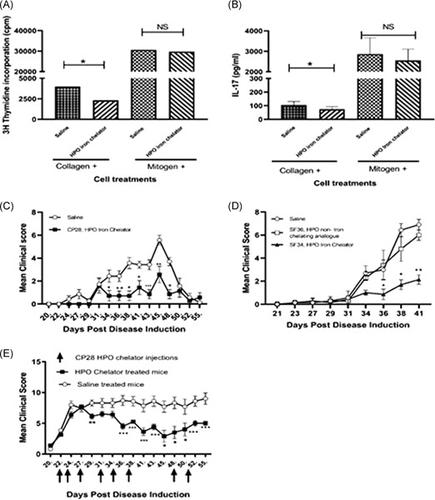当前位置:
X-MOL 学术
›
Immun. Inflamm. Dis.
›
论文详情
Our official English website, www.x-mol.net, welcomes your
feedback! (Note: you will need to create a separate account there.)
HPO iron chelator, CP655, causes the G1/S phase cell cycle block via p21 upregulation.
Immunity, Inflammation and Disease ( IF 3.1 ) Pub Date : 2020-08-31 , DOI: 10.1002/iid3.342 Damini Tewari 1 , Katie Lloyd-Jones 1 , Robert C Hider 2 , Helen Collins 1
Immunity, Inflammation and Disease ( IF 3.1 ) Pub Date : 2020-08-31 , DOI: 10.1002/iid3.342 Damini Tewari 1 , Katie Lloyd-Jones 1 , Robert C Hider 2 , Helen Collins 1
Affiliation

|
Iron is known not only for its importance in cellular and metabolic pathways but also for its role in causing cellular toxicities such as production of reactive oxygen species and growth of pathogens. The inability of the human body to physiologically excrete excess iron highlights the need to develop a cheap yet effective iron chelator. This study provides initial evidence of the therapeutic and prophylactic properties of 3‐hydroxypyridin‐4‐one (HPO) chelators in murine collagen‐induced arthritis. To determine whether these chelators would be effective on human cells, we tested a panel of different HPO chelators and identified 7‐diethylamino‐N‐((5‐hydroxy‐6‐methyl‐4‐oxo‐1,4‐dihydropyridin‐3‐yl)methyl)‐N‐methyl‐2‐oxo‐chromen‐3‐carboxamide (CP655) as the most effective compound targeting human CD4+ T cells. Treatment with CP655 causes significant inhibition of cell proliferation and production of inflammatory cytokines such as interferon‐γ and interleukin‐17. Microarray analysis revealed dysregulation in cell cycle‐related genes following CP655 treatment. This was validated by flow cytometry demonstrating a G1/S phase block caused by CP655. Finally, mechanistic experiments revealed that the chelator may be causing an upregulation of the cell cycle inhibitor protein CDKN1A (p21) as a possible mechanism of action. In conclusion, this study demonstrates that HPO chelators could prove to have therapeutic potential for diseases driven by excessive T cell proliferation.
中文翻译:

HPO 铁螯合剂 CP655 通过 p21 上调引起 G1/S 期细胞周期阻滞。
铁不仅因其在细胞和代谢途径中的重要性而闻名,而且因其在引起细胞毒性(例如活性氧的产生和病原体的生长)中的作用而闻名。人体无法在生理上排出多余的铁,这凸显了开发廉价而有效的铁螯合剂的必要性。该研究提供了 3-羟基吡啶-4-酮 (HPO) 螯合剂在小鼠胶原诱导性关节炎中的治疗和预防特性的初步证据。为了确定这些螯合剂是否对人体细胞有效,我们测试了一组不同的 HPO 螯合剂并鉴定了 7-二乙氨基-N -((5-hydroxy-6-methyl-4-oxo-1,4-dihydropyridin-3-基)甲基) -N-methyl-2-oxo-chromen-3-carboxamide (CP655) 作为靶向人类 CD4+ T 细胞的最有效化合物。CP655 治疗可显着抑制细胞增殖和炎性细胞因子(如干扰素-γ 和白细胞介素-17)的产生。微阵列分析揭示了 CP655 治疗后细胞周期相关基因的失调。这通过流式细胞术证实了由 CP655 引起的 G1/S 期阻滞。最后,机械实验表明,螯合剂可能导致细胞周期抑制剂蛋白 CDKN1A (p21) 的上调,这是一种可能的作用机制。总之,这项研究表明 HPO 螯合剂可以证明对由过度 T 细胞增殖驱动的疾病具有治疗潜力。
更新日期:2020-08-31
中文翻译:

HPO 铁螯合剂 CP655 通过 p21 上调引起 G1/S 期细胞周期阻滞。
铁不仅因其在细胞和代谢途径中的重要性而闻名,而且因其在引起细胞毒性(例如活性氧的产生和病原体的生长)中的作用而闻名。人体无法在生理上排出多余的铁,这凸显了开发廉价而有效的铁螯合剂的必要性。该研究提供了 3-羟基吡啶-4-酮 (HPO) 螯合剂在小鼠胶原诱导性关节炎中的治疗和预防特性的初步证据。为了确定这些螯合剂是否对人体细胞有效,我们测试了一组不同的 HPO 螯合剂并鉴定了 7-二乙氨基-N -((5-hydroxy-6-methyl-4-oxo-1,4-dihydropyridin-3-基)甲基) -N-methyl-2-oxo-chromen-3-carboxamide (CP655) 作为靶向人类 CD4+ T 细胞的最有效化合物。CP655 治疗可显着抑制细胞增殖和炎性细胞因子(如干扰素-γ 和白细胞介素-17)的产生。微阵列分析揭示了 CP655 治疗后细胞周期相关基因的失调。这通过流式细胞术证实了由 CP655 引起的 G1/S 期阻滞。最后,机械实验表明,螯合剂可能导致细胞周期抑制剂蛋白 CDKN1A (p21) 的上调,这是一种可能的作用机制。总之,这项研究表明 HPO 螯合剂可以证明对由过度 T 细胞增殖驱动的疾病具有治疗潜力。











































 京公网安备 11010802027423号
京公网安备 11010802027423号